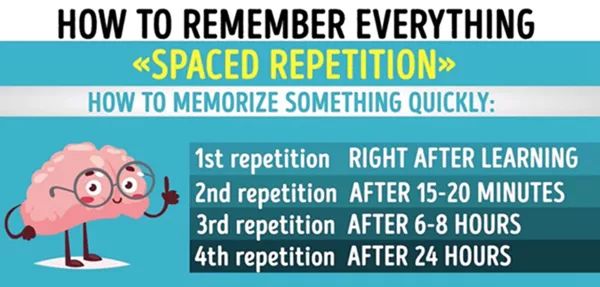The biggest advantage of the forgetting curve memory method is not that you remember what you have learned, but that your mind is trained to be accustomed to long-term memory
The question I am most often asked is how can a person read so many books and remember them for so long.
As an undergraduate in the Mathematics Department, I wrote an article to the Beijing Evening News about the "forgetting curve" memory method, which is still popular 40 years later.
As Figure 1 shows, if you only want to memorize something "short" (the final exam), then the forgetting curve (Ebbinghaus's study at the end of the 19th century) means that you can review these things once as soon as you remember them, then review them a second time after 15 minutes, a third time after 6 hours, and a fourth time after a day.

I prefer to remember anything for a long time, so I prefer Figure 2. In fact, I was carrying a large open photocopy of the Oxford Double Solution Dictionary bought by the eight-sided slot in-house bookstore, first using word cards to copy new words, then using leather bands to tie dozens of new word cards into a stack and put them in the left pocket, following the "forgetting curve" at least five times that day, reviewing at least twice the next day, reviewing once after three or four days, and reviewing once a month later. In my experience, the proportion of forgetting dropped to 1%.
I used this method, Figure I instead of Figure II, the craziest one was in 1985, when I visited the East-West Center in Hawaii to study, in fact, I was preparing for the GRE exam, the office carpet was covered with flashcards, the whole room was white, I walked around and reviewed thousands of words (all of which were the kind of cold words in the appendix to the GRE review set), and the next day the shuffle was covered with carpets. In short, memorizing more than 2,000 words in the GRE appendix in a month is easy to achieve.
The biggest advantage of the forgetting curve memory method is not that you remember what you have learned, but that it trains your mind to get used to long-term memory, which I think is a set of techniques that have helped me throughout my life. The rest of the screenshots here, like the first two, come from my newly downloaded short video "11 cheats that make you remember content faster than others", but I only selected the recommended ones, deleting four "cheats" that are not very suitable for Chinese thinking mode.
Figure 3 proposes to select only the best materials. It's not a cheat either, the question is, how do you know which book is the best? Therefore, I wrote at the beginning of "The Basic Problems of the History of Ideas" that the best beginning of any discipline may be the intellectual history of this discipline. You have to read the history of mathematical thought to know which mathematical books are "best", you have to read the history of economic thought to know which economics books are the best, you have to read the history of psychological thought to know which psychology books are the best... etcetera. Otherwise, you are wasting your life.
Figure 4 says, try to understand what you're transferring from short-term memory to long-term memory. This can be particularly important, I have drawn two curves, the scale of the horizontal axis is age, the scale of the vertical axis, the first curve, is memory, about 15 years old, but most people do not decline significantly until the age of 50. The second curve, understanding, rises from about the age of 7, most people are not obvious, until 25 to 35 years old, only to feel that understanding has a significant increase, about 45 to 65 years old, most people rise slowly. Remember, the "exception" to comprehension is particularly important, and many people feel an increase in comprehension at the moment of life and death. The longitudinal superposition of these two curves is the third curve, but it is difficult to tell whether it is continuous, roughly speaking, as the age increases, comprehension replaces memory, so labor productivity continues to increase or remain unchanged, until comprehension also begins to decline (90 years old).
Figure 5 says try to place the most important content in any unit of knowledge at the beginning and end of the unit.
Figure 6 refers to trying to divert attention to completely unrelated things in half an hour or an hour while learning a particular unit of knowledge, giving your "unconscious" mind a break.
Looking at Figure VII, this is the art of critical thinking, and while learning any theory, it is necessary to learn other theories that are opposed to or have major differences with this theory.
As shown in Figure 8, do not easily organize the layout of documents and books stored in your study desk bookshelf computer and mobile hard disk, because the existing spatial relationship between these books and documents is a memory clue for you to retrieve the content. Therefore, every time Marx found Yanni tidying up his study, he might lose his temper. To be honest, I did the same myself, until after I transferred all my book knowledge to laptops and portable hard drives.
Figure 9 says that knowledge is "visualized" as much as possible.
The author is a professor at the National Institute of Development Studies, Peking University, and this article is from Caixin.